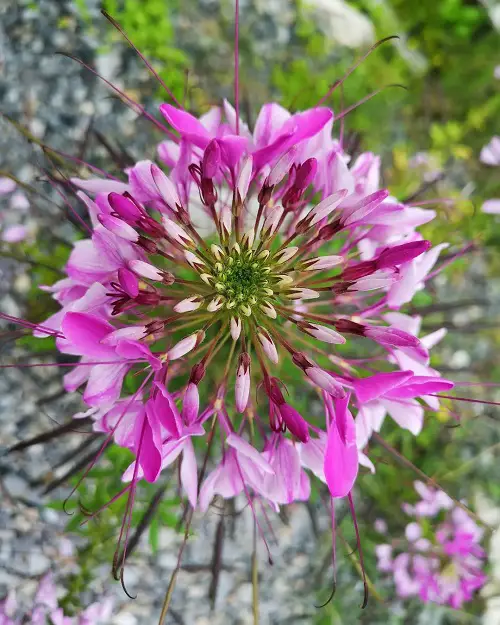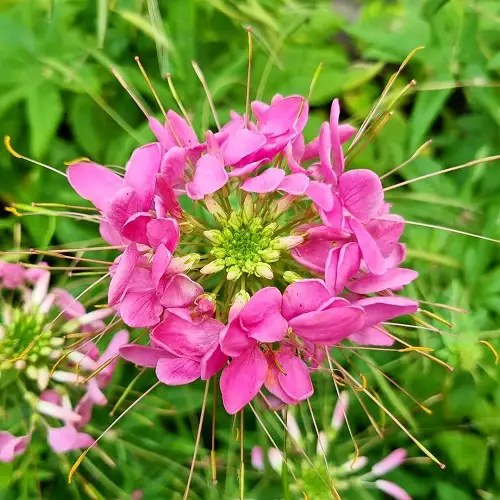Is There a Pink Spider Plant? If you, too, have this question, then keep on reading to find an interesting answer!

Is There a Pink Spider Plant? Do they really exist? If you are confused about their existence, then don’t worry. We are here to take the wrap of the truth!
Is There a Pink Spider Plant?
No. There is no pink spider plant. People confuse Tradescantia spathacea, which is also popular as Boat Lily, Oyster Plant, Cradle Lily, Moses-in-the-Cradle, as pink spider plant as their leaves look quite similar, but they are NOT the same plants!
Spider plants come in a lot of color combinations, but none of them sports a pink hue. If you are a fan of green and yellow variegations in spider plants, then you can grow:
- Chlorophytum comosum ‘Vittatum’: This is the classic spider plant variety with green leaves that have a central white stripe running down the middle. It’s widely available and easy to grow.
- Chlorophytum comosum ‘Variegatum’: This variety has green leaves with white stripes, similar to ‘Vittatum,’ but with more pronounced variegation.
- Chlorophytum comosum ‘Bonnie’: ‘Bonnie’ has curly, twisted leaves with a mix of green and creamy white variegation. Its unique foliage adds a touch of whimsy to any space.
- Chlorophytum comosum ‘Mandarin’: ‘Mandarin’ is a stunning variety with green leaves and vibrant orange stripes. It adds a pop of color and visual interest to your indoor garden.
- Chlorophytum comosum ‘Hawaiian’: This variety features green leaves with a central yellow stripe, giving it a tropical and vibrant appearance.
- Chlorophytum comosum ‘Milky Way’: ‘Milky Way’ has green leaves with white spots or flecks, resembling a starry night sky. It will add a unique and artistic touch to your plant collection.
What About Spider Flower?

There is no pink spider plant, but there is definitely a pink spider flower, which is Cleome spinosa. It is an annual flowering plant native to South America. It is known for its unique and showy flowers that resemble spider legs, hence its common name.
Cleome spinosa is a tall, upright plant that can reach heights of 2 to 5 feet (60 to 150 centimeters). It has palmately compound leaves with 5 to 7 leaflets that radiate from a central point. The leaves can vary in color from green to purple.
The flowers of Cleome spinosa are the plant’s main attraction. They grow in clusters on long stems and feature slender, spidery petals that can be pink, white, purple, or a combination of these colors. The flowers have long stamens, which give them a unique and eye-catching appearance. They bloom from late spring to fall, attracting pollinators like bees and butterflies.
Requirements for Growing Pink Spider Plant (Flower)

- Sunlight: Spider flowers thrive in full sun, receiving at least 6 to 8 hours of direct sunlight each day. They can tolerate some partial shade, but flowering may be reduced in shadier conditions.
- Soil: Cleome spinosa prefers well-draining soil with a slightly acidic to neutral pH (around 6.0 to 7.0). The soil should be fertile and rich in organic matter. Amend heavy or clay soils with organic compost to improve drainage.
- Watering: Spider flowers require regular watering to keep the soil moist but not waterlogged. Provide deep, thorough watering when the top inch of soil feels dry. Be mindful not to overwater, as excessive moisture can lead to root rot.
- Temperature: Spider flowers are warm-season annuals and thrive in temperatures between 65°F and 85°F (18°C to 29°C). They are not frost-tolerant, so plant them after the last frost date in your area.
- Pruning: Cleome spinosa may benefit from occasional pruning to encourage bushier growth and extend the blooming period. Remove spent flowers to prevent seed formation and promote the production of new blooms.
- Pests and Diseases: Spider flowers are generally resistant to most pests and diseases. However, keep an eye out for aphids, spider mites, and powdery mildew. Treat any pest or disease issues promptly with organic or appropriate insecticides or fungicides.


